Every year, Healthcare Ready conducts and releases a National Disaster Preparedness Poll to increase communities’ disaster preparedness efforts across the United States. With an average of 17 hurricanes striking every decade and an annual average of 70 wildfires burning 7 million acres of land in the U.S., it’s not surprising that more than half of Americans think it’s likely a major disaster will impact their family in the next five years.
Americans are most concerned that a natural disaster will affect their community. This concern holds for every region, every age group, and every race in the U.S. The South has the highest proportion of respondents who believe it is likely that a major disaster will impact their community. Concerns about a natural disaster increase with age.
Concerns about an exotic disease spiked dramatically in 2020, but dropped by at least half in 2021. The Northeast region in the U.S. is most concerned about this kind of disaster.
Despite the concerns about a natural disaster in the midst of a global public health crisis, Americans overall are not well-prepared for a disaster’s impacts on their community. Less than half of Americans can list all of their prescription information. White Americans have the highest percentage of persons who can list all of this information meanwhile ¼ of Black Americans and 21% of Americans age 18-34 can list all of this information.
Less than half of Americans have an emergency plan in place in the case of a disaster, and less than 30% of Americans currently keep an emergency bag packed with supplies. Less than 40% of Americans keep copies of their medical records stored in a safe place. Less than half of Americans keep cash on hand in the case of an emergency, with Hispanic Americans least likely to keep cash on hand, and lower income persons and 18–34 year old’s much less likely to do this.
What can be done to address this gap in national disaster preparedness? First is to address the ongoing COVID-19 pandemic. Yet even this step seems a large task at present.
Only ¼ of unvaccinated Americans are willing to receive a COVID-19 vaccine, and over 40% of unvaccinated Americans are not at all willing to receive a vaccine. This total unwillingness applies significantly less to Americans aged 18-34. About half of unvaccinated Americans say that not trusting the vaccine is the reason for not receiving it, with this reason much more likely among White Americans, and those who are 55 years and older. Increased efforts in disseminating accessible vaccine education materials and building trust in the vaccine and providers should be a priority so that Americans can make an informed decision about vaccination.
One of the most dangerous factors in disaster preparedness is being overly comfortable in those efforts. While the reported statistics may feel daunting, the good news is that closing these preparedness gaps is nothing we as a national community cannot handle, it just means we have more work to do.






